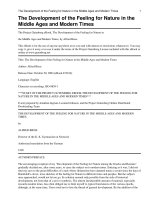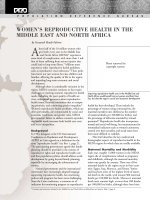From Privilege to Competition - Unlocking Private-Led Growth in the Middle East and North Africa pot
Bạn đang xem bản rút gọn của tài liệu. Xem và tải ngay bản đầy đủ của tài liệu tại đây (1.24 MB, 278 trang )
MENA DEVELOPMENT REPORT
From Privilege to
Competition
Unlocking Private-Led Growth in
the Middle East and North Africa
F rom Privilege to
Competition
F rom Privilege to
Competition
Unlocking Private-Led
Growth in the Middle East
and North Africa
MENA DEVELOPMENT REPORT
THE WORLD BANK
Washington, D.C.
© 2009 The International Bank for Reconstruction and Development / The World Bank
1818 H Street NW
Washington DC 20433
Telephone: 202-473-1000
Internet: www.worldbank.org
E-mail:
All rights reserved
123412111009
This volume is a product of the staff of the International Bank for Reconstruction and
Development / The World Bank. The findings, interpretations, and conclusions expressed in
this volume do not necessarily reflect the views of the Executive Directors of The World Bank
or the governments they represent.
The World Bank does not guarantee the accuracy of the data included in this work. The
boundaries, colors, denominations, and other information shown on any map in this work do
not imply any judgement on the part of The World Bank concerning the legal status of any
territory or the endorsement or acceptance of such boundaries.
Rights and Permissions
The material in this publication is copyrighted. Copying and/or transmitting portions or all of
this work without permission may be a violation of applicable law. The International Bank for
Reconstruction and Development / The World Bank encourages dissemination of its work and
will normally grant permission to reproduce portions of the work promptly.
For permission to photocopy or reprint any part of this work, please send a request with
complete information to the Copyright Clearance Center Inc., 222 Rosewood Drive, Danvers,
MA 01923, USA; telephone: 978-750-8400; fax: 978-750-4470; Internet: www.copyright.com.
All other queries on rights and licenses, including subsidiary rights, should be addressed to the
Office of the Publisher, The World Bank, 1818 H Street NW, Washington, DC 20433, USA;
fax: 202-522-2422; e-mail:
ISBN-13: 978-0-8213-7877-9
eISBN: 978-0-8213-7889-2
DOI: 10.1596/978-0-8213-7877-9
Library of Congress Cataloging-in-Publication Data
Benhassine, Najy.
From privilege to competition : unlocking private-led growth in the Middle East and North
Africa / [Najy Benhassine, principal author].
p. cm. (Mena development report)
ISBN 978-0-8213-7877-9 ISBN 978-0-8213-7889-2
1. Economic development Middle East. 2. Economic development Africa, North. 3. Public-
private sector cooperation Midde East. 4. Public-private sector cooperation Africa, North.
I. World Bank. II. Title.
HC415.15.B465 2009
338.956'05 dc22
2009030180
Cover photo: Zoubida Allaoua and Catherine H. Burtonboy
Cover design: Naylor Design
Foreword xiii
Preface xvii
Acknowledgments xxiii
Glossary of Terms xxvii
Abbreviations xxix
Overview 1
What Is This Report About? 1
Is the Private Sector Able to Play the Role of a
Growth Engine? 2
How Has the Private Sector Performed So Far? 3
Is It about Missing Reforms? 6
Is It about the Way Rules Are Implemented? 9
Why Is It Difficult to Improve the Business Environment
in the Region? 12
Weak Demand for Reform: A Private Sector That Has Yet to
Become an Agent of Change 13
Weak “Supply” of Reforms: Policy-Making Institutions
That Lack Credibility 14
What Should Be Done Differently? Where Should Each
Country Start? 15
Getting Specific: A Roadmap for Credible Private-Led
Growth Strategies in MENA 16
Looking Forward 22
1. Voices of Entrepreneurs—Stories of Success,
Hope, and Challenge 25
Listening to Entrepreneurs 27
Government Successes and Pitfalls in Supporting
the Private Sector 30
Contents
v
Challenges Facing Entrepreneurs—From Regulatory
Barriers to Conflict and War 31
Privileges, Unlevel Playing Fields, and the Credibility
of the Reforms 35
Hope and Enthusiasm for the Future 38
Part I Private Sector Performance in the MENA Region:
Explaining the Untapped Potential 43
2. Searching for Signs of Sustained Private-Led
Growth in MENA 45
The Growth of MENA Economies 46
An Economy-Wide Perspective 50
Firm-Level Productivity 63
Summing Up 65
3. Explaining the Private Sector’s Weak
Performance—An Organizing Framework 69
The Need for Humility in Prescribing the Keys to
Private-Led Growth 69
Policies, Institutions That Implement Them, and
Expectations about the Future 71
Measuring Rules, How They Are Applied, and
Expectations about the Future 75
4. Policy Reforms in MENA,Their Credibility, and Their
Implementation 79
Is the Problem with Missing Reforms? 80
The Problem Is the Insufficient Private Sector
Response to Reforms 84
Is It about the Way Rules and Policies Are Implemented? 86
Symptoms of a Business Environment That Is Not
the Same for All 97
Summing Up 104
Part II Policies and How They Are Applied:
State Intervention and Discretion in Credit,
Land, and Industrial Policy 107
5. Access to Credit in MENA: Toward Better
Supervision and Less Interference 109
Credit Markets and Banking Systems in MENA 111
Business Manager Perceptions of Credit Constraints 113
Beyond Perceptions and Complaints: How Many
Firms Are Really Credit Constrained? 114
What Can Governments Do to Increase Access to Credit? 117
vi Contents
Contents vii
6. Reassessing the State’s Role in Industrial
Land Markets 129
The Low Access to Land in MENA Countries 130
Sources of Inefficiencies in Land Markets 132
Getting the Incentives Right in Enclaves 142
Power and Rent Seeking in Public Land Allocation
and Regulation 143
The Way Forward 145
7. New Industrial Policies: Opportunities and
Perils of Selective Interventions 151
A Tradition of Subsidies and Selective State Interventions 152
A Framework to Clarify a Controversial Debate 153
Private Sector Policies in MENA—A Legacy of
Disproportionate Interventionism 159
Assessing Risks of Industrial Policy Interventions 162
Should Oil-Rich Countries Intervene? Yes, but the
Risks of Failure Are Higher 166
A Final Cautionary Note: Industrial Policies Could Succeed
if the Right Conditions and Processes Are in Place 167
Part III Designing Credible Private Sector Reforms
Informed by Political Economy Realities 169
8. Institutions and State-Business Alliances
Constraining Reforms and Credibility 171
Weak Supply of Reforms: Policy-Making Institutions
That Lack Commitment and Credibility 173
Weak Demand for Reform: A Private Sector That Has
Yet to Become an Agent of Change 182
What Can Reformers Do to Change the Political
Economy Status Quo? 191
9. Rethinking Private Sector Policy Making in MENA 195
What Should Be Done Differently to Realign
Investor Expectations? 196
Looking Forward: Unlocking the Region’s Private
Sector Potential 207
References 209
Index 219
viii Contents
Tables
4.1 Private Sector Priority Constraints from
Enterprise Surveys, 2003 and 2005–08 88
5.1 Efficiency of Credit Markets 110
6.1 Registering Property (2009) 130
6.2 Industrial Land Prices in Selected MENA Countries 137
8.1 The Public Sector Wage Bill in MENA and
Comparator Countries, 2001–05 179
8.2 Advocacy Priorities of Business Associations
Do Not Match the Top Constraints of Enterprises 189
Figures
0.1 Stagnating Private Investment Rates 4
0.2 Lower Diversification of Exports 5
0.3 The Number of Regulatory Reforms Has
Increased Recently in MENA Countries 7
0.4 Reform Episodes and Private Investment Response 7
0.5 Overall, the Business Environment in MENA
Countries Looks “Average,” as It Does in Many
Fast-Growing Economies 8
0.6 Policy Uncertainty and the Unequal Implementation
of Rules Are Leading Constraints to Businesses 10
0.7 Perceptions about the Consistency and Predictability
of Rules and Regulations as They Are Applied in
MENA Countries 10
0.8 The Lasting Influence of the Business Elite and the
Lack of Dynamism and Competition in the Private
Sector 11
1.1 Most MENA Economies Are Private Sector Based,
2005 and Previous Decades 26
2.1 Middle East and North Africa’s Weak Growth
in International Perspective 48
2.2 Middle East and North Africa’s Growth over the
Long Term 49
2.3 Contributions to the Growth of GDP in
2007—Insufficient Role for Exports 51
2.4 Private Investment as a Share of Total Investment 52
2.5 Private Investment as a Share of GDP, 1995–2006 53
2.6 Gross Private Investment, 1980–2006 54
2.7 Net FDI Flows as a Share of GDP, 1970–2005 54
2.8 Structure of Foreign Direct Investment,
Cumulative 2000–07 55
2.9 Manufactured Exports to GDP, 1965–2006 59
2.10 Recent Export Growth among MENA’s
Resource-Poor, Labor-Abundant Countries 60
Contents ix
2.11 Technology Content of Exports: Medium- and
High-Technology Exports 61
2.12 Number of Products Exported 62
2.13 Lower Diversification of Exports 63
2.14 Proportion of New Products in 2006 Export Basket 64
2.15 Total Factor Productivity: MENA Countries
and Comparators 65
2.16 Labor Productivity: MENA Countries and Comparators 66
3.1 The Firm and Its Investment Climate 71
3.2 The Firm and Its Investment Climate: Rules and
Policies and the Institutions That Implement Them 74
4.1 Overall, the Business Environment in MENA
Countries Looks “Average,” as It Does in Many
Fast-Growing Economies 81
4.2 The Number of Regulatory Reforms Has Increased
Recently in MENA Countries 82
4.3 MENA Tariff Reductions Top Those of All Other
Regions, 2000–07 82
4.4 Private Investment Has Been Rising 84
4.5 MENA Business Creation between 2002 and 2005
Leads the Developing World 85
4.6 Reform Episodes and Private Investment Response 85
4.7 Private Investment’s Response to More than a
Decade of Reforms Has Been Relatively Weak,
1990 and 2006 86
4.8 Large Proportions of Investors Complain That
the Regulations Are Interpreted Inconsistently
and Unpredictably 87
4.9 Policy and Regulatory Uncertainty Are Leading
Constraints to Businesses 89
4.10 Days Spent in Inspections or Required Meetings
with Officials 91
4.11 Senior Management’s Time Spent Dealing with
Regulations 92
4.12 Inspections Where an Informal Payment Is
Requested or Expected 92
4.13 Perception of the Corruption Constraint
among MENA Firms 93
4.14 Most MENA Countries Lag behind International
Norms in Their Corruption Ranking 94
4.15 Anticompetitive/Informal Practices 95
4.16 Entrepreneurs from Lebanon Complain
about Competitors’ Practices 96
4.17 Revenue Reported by Typical Establishment for
Tax Purposes 96
x Contents
4.18 The Lasting Influence of the Old Business Elite
in MENA: Older Firms 98
4.19 The Lasting Influence of the Old Business
Elite in MENA: Older Entrepreneurs among
Younger Populations 99
4.20 Less Educated Business Owners 100
4.21 Business Creation and Entry into Export Markets 100
4.22 Entrepreneurship in MENA and Other Regions 101
4.23 Dispersion in Value-Added per Worker 103
4.24 Competition in Manufacturing 103
5.1 Total Credit to the Private Sector Compares
Well with Other Developing Regions, 2007 111
5.2 Beyond Regional Averages: Diversity in the
Efficiency of MENA Credit Markets, 2007 112
5.3 Banking Sector Penetration Is Low 112
5.4 Dissatisfaction with Access to Finance 113
5.5 Dissatisfaction Increases with the Demand for Credit 114
5.6 How Firms Use Bank Credit 115
5.7 Credit Constraints Are Stronger in Countries
That Have Reformed Less 115
5.8 Smaller Firms Are More Credit Constrained
Than Larger Firms 116
5.9 Transparency in Financial Statements Helps to Enter
the Credit Market 116
5.10 MENA’s Nonperforming Loans—Highest in
the World 118
5.11 The Risk of Nonperforming Loans—Higher with
State-Owned Banks 119
5.12 Credit Information in MENA 124
5.13 Collateral Legislation and Creditors’ Rights in MENA 124
5.14 Foreign Ownership of Banks in MENA 126
6.1 Access to Industrial Land Is Perceived More
Often as a Major Constraint to Businesses
in MENA Countries 131
6.2 Ownership Status of Industrial Land in MENA
Countries 134
6.3 Master Developer Requirements to Invest in
Industrial Zones 148
7.1 The Basic Framework: Government Subsidies by
Degree of Firm Selectivity 155
8.1 The Effects of Ruling Party Institutionalization on
Private Investment 174
8.2 Party Institutionalization in MENA and Comparator
Countries, 2004 176
Contents xi
Boxes
2.1 An Emerging Consensus on the Link between
Export Diversification and Growth 57
5.1 Bank Bailouts and the Financial Crisis—A Return
to Nationalizations or a Temporary Cure? 120
5.2 Credit Rationing and the Availability of Credit
Information 123
8.1 The Gulf Cooperation Council: Exception to the
Resource Curse? 181
8.2 Oil Rents, Foreign Aid Rents, and the
(Dis)Incentives to Institutionalize 183
8.3 The Genesis of Business Elites in Morocco 185
9.1 Cairo’s One-Stop Shop 199
9.2 The Federal Institute of Access to Public
Information in Mexico 203
x Contents
4.18 The Lasting Influence of the Old Business Elite
in MENA: Older Firms 98
4.19 The Lasting Influence of the Old Business
Elite in MENA: Older Entrepreneurs among
Younger Populations 99
4.20 Less Educated Business Owners 100
4.21 Business Creation and Entry into Export Markets 100
4.22 Entrepreneurship in MENA and Other Regions 101
4.23 Dispersion in Value-Added per Worker 103
4.24 Competition in Manufacturing 103
5.1 Total Credit to the Private Sector Compares
Well with Other Developing Regions, 2007 111
5.2 Beyond Regional Averages: Diversity in the
Efficiency of MENA Credit Markets, 2006 112
5.3 Banking Sector Penetration Is Low 112
5.4 Dissatisfaction with Access to Finance 113
5.5 Dissatisfaction Increases with the Demand for Credit 114
5.6 How Firms Use Bank Credit 115
5.7 Credit Constraints Are Stronger in Countries
That Have Reformed Less 115
5.8 Smaller Firms Are More Credit Constrained
Than Larger Firms 116
5.9 Transparency in Financial Statements Helps to Enter
the Credit Market 116
5.10 MENA’s Nonperforming Loans—Highest in
the World 118
5.11 The Risk of Nonperforming Loans—Higher with
State-Owned Banks 119
5.12 Credit Information in MENA 124
5.13 Collateral Legislation and Creditors’ Rights in MENA 124
5.14 Foreign Ownership of Banks in MENA 126
6.1 Access to Industrial Land Is Perceived More
Often as a Major Constraint to Businesses
in MENA Countries 131
6.2 Ownership Status of Industrial Land in MENA
Countries 134
6.3 Master Developer Requirements to Invest in
Industrial Zones 148
7.1 The Basic Framework: Government Subsidies by
Degree of Firm Selectivity 155
8.1 The Effects of Ruling Party Institutionalization on
Private Investment 174
8.2 Party Institutionalization in MENA and Comparator
Countries, 2004 176
Contents xi
Boxes
2.1 An Emerging Consensus on the Link between
Export Diversification and Growth 57
5.1 Bank Bailouts and the Financial Crisis—A Return
to Nationalizations or a Temporary Cure? 120
5.2 Credit Rationing and the Availability of Credit
Information 123
1 Banking Reform Can Reduce the Financing Gap 123
8.1 The Gulf Cooperation Council: Exception to the
Resource Curse? 181
8.2 Oil Rents, Foreign Aid Rents, and the
(Dis)Incentives to Institutionalize 183
8.3 The Genesis of Business Elites in Morocco 185
9.1 Cairo’s One-Stop Shop 199
9.2 The Federal Institute of Access to Public
Information in Mexico 203
Foreword
Times of economic turmoil often overshadow long-term challenges.
However, the current global economic crisis could be a historic oppor-
tunity for the Middle East and North Africa region. It could open the
door for fundamental reforms that will prepare the countries of this re-
gion to rebound, embrace the future global recovery, and strengthen
their long-term growth prospects.
From Privilege to Competition: Unlocking Private-Led Growth in the
Middle East and North Africa complements previous regional reports
published by the World Bank by focusing on the role of the private sec-
tor as an engine for stronger growth and employment creation. The
2004 report on trade and investment and the 2008 report on education
touched on other fundamental ingredients of economic competitiveness
and private sector development. This report—focusing on market insti-
tutions, the quality of implementation of economic policies, and the
credibility of reforms from the private sector perspective—offers a new
angle to the growth and development challenges of the MENA region.
Stronger Private Sector Growth is Needed
to Create Jobs.
All countries in the region face a pressing employment challenge: about
40 million jobs will need to be created in the coming decade. A young
and increasingly well educated labor force is looking for opportunities
to use their skills and creativity. Governments will not be able to create
these jobs in the public sector—nor will state-owned enterprises in a
sustainable manner. The jobs will have to come from the private sector.
The future prosperity and social cohesion of the MENA region rests
in great part on the ability of governments to enable the private sector to
respond to this job creation challenge. That is what this report is about:
enabling new generations of entrepreneurs to play a bigger role in the
xiii
xiv Foreword
growth of their countries. It is also about encouraging more investors to
believe in the prospects of the region and trust that business-friendly pol-
icy reforms will benefit them as well—and not only a minority of privi-
leged entrepreneurs.
Skeptics voicing doubt that the private sector will succeed in generat-
ing the needed jobs and growth are legion in MENA, and the global fi-
nancial crisis may have added to this skepticism. However, the lessons of
past crises support the main message of this report: sustained job creation
can only come from a competitive private sector, which in turn requires
governments to build efficient regulatory capacity. Where regulatory in-
stitutions are weak or where regulators are captured, the state cannot
play its supportive role effectively.
A more vibrant private sector in MENA countries will also contribute
to increased economic integration of the region. With a conducive busi-
ness environment, new entrepreneurs will emerge to reap the benefits of
greater intraregional trade and investment—driven more by business
considerations than by political concerns.
While There Have Been Policy Reforms, Their
Implementation Needs to Improve to Foster a Stronger
Response From the Business Community.
In many MENA countries the institutions that implement private sec-
tor policies, need strengthening to make reforms more credible, and to
ensure that they are implemented equitably and consistently to the ben-
efit of all entrepreneurs.
This region has made great strides over the last few years in improv-
ing its investment climate—even if some countries still lag. Yet the re-
sponse of the private sector has been muted. Arbitrary implementation
of reforms and discretion in enforcing rules explain why too many
would-be entrepreneurs believe that the key to success is how con-
nected, or how privileged, they are, which diminshes the importance of
competition, creativity, and persistence. Focusing on the credibility of
reforms and the consistency of their implementation is what this report
recommends. This new agenda for private sector development applies
to all countries in the region, even if it translates into different strategies
depending on each country’s specifics, its progress with business envi-
ronment reforms, its resource endowment, and its political economy.
This new agenda emphasizes the role of institutional reform as the
cornerstone of any credible private sector development strategy, and is
therefore in essence a “good governance” agenda. The aim is to increase
the effectiveness and consistency in which public agencies and market
institutions—customs, tax authorities, investment agencies, courts, indus-
trial land market agencies, and so forth—interact with firms and enforce
regulations. The report argues that reforms need to reduce conflicts of
interests and target regulations that either restrict competition or erect in-
formal barriers to entry. These reforms will all require visible actions by
political leaders to signal that there will be a level playing field. The cred-
ibility of these signals will ultimately be the most important driver of pri-
vate investors’ response to reforms.
The Private Sector Also Has a Responsibility: It Needs
to Be Better Organized and Be More Inclusive, More
Creative and More Dynamic in Order to Be a Credible
Partner of Governments in Implementing this Agenda.
The report argues that the private sector and civil society, too, have an
important role to play in changing expectations for the better. It shows
that in many countries, the dominant private sector—privileged by past
policies and remaining distortions—is seldom an agent of change, but
tends to defend the status quo. New generations of entrepreneurs, ones
that are more open to competition, exports, and innovation, need to
voice their interests more prominently. To this end, they need to be bet-
ter organized. The same is true for civil society. The demand for re-
forms is often weak in MENA countries—sometimes because channels
of voice are muted, but often because these voices are not unified or or-
ganized. The report calls on the private sector and civil society to play a
bigger role in support of reformers in their governments.
This report offers innovative ideas and recommendations for policy-
makers, the private sector, and civil society in the MENA region and
beyond, and it will generate debates and discussions to help the private
sector to grow and create the jobs that are badly needed. The World
Bank stands ready to support our MENA client countries in this
endeavor.
S
HAMSHAD AKHTAR
REGIONAL VICE-PRESIDENT
MENA REGION
Foreword xv
Preface
The objectives and intended impacts of this report are threefold: in-
forming policy makers and other stakeholders, proposing a new angle on
private sector policies, and provoking a debate.
First, informing. The report brings together new evidence on private
sector development across the Middle East and North Africa (MENA),
as well as the findings from the literature on this topic, particularly
country-specific analysis. Its aim is to present current knowledge on busi-
ness environment challenges in MENA—at least on selected issues pre-
sumed to be most pertinent to the region. It also aims to inform policy
makers and other stakeholders of successful policy reforms in the region
or elsewhere.
Second, proposing a new perspective on public policies shaping the
investment climate. This report is prescriptive, offering new routes for
policy reforms. Rather than reiterate the list of standard reforms that
might be ongoing in the region, this report will offer different angles to
the business environment reform agenda. For example, in the legal and
regulatory environment, the report emphasizes the institutional under-
pinnings of the reform process and its public sector governance aspects.
Similarly, for industrial strategies the report will distance itself from dog-
matic views on whether they are good or bad. Instead, it will focus on the
institutional underpinnings of good industrial strategies, as well as on the
design and evaluation of these interventions.
Third, provoking a debate. Ultimately, this report aims to bring pub-
lic sector governance to the center of the private sector development
agenda. Public sector governance, accountability, transparency, credibil-
ity, rents, privileges, discretion, and state capture are terms sprinkled
throughout the report, much more prominently than the vocabulary usu-
ally associated with the private sector—technology, innovation, entre-
preneurship, competitiveness centers, small and medium-sized enter-
prises, incubators, and the like. Another objective of this report is to
provoke debate among stakeholders in the MENA countries and to raise
xvii
xviii Preface
awareness that the private sector agenda in this region is mostly one of
public governance.
A poll of 3,900 citizens of six Arab countries conducted in late 2005,
identified “Ending corruption and nepotism” as the third most important
concern of citizens after job creation and improving the health care or
education systems.
1
Depending on the country, nepotism is also cited as
the first or second reason why employment opportunities are hard to
find. This report in a sense links the two issues by showing that discre-
tionary policy implementation and rent-seeking distortions—both
manifestations of nepotism—are constraining private investment and job
creation in the region.
The report is intended for multiple audiences: governments, the
private sector, and the public at large. For the policy makers in MENA,
and particularly the reformers among them—whether in government,
in parliaments, or in various ruling circles—the report proposes concrete
policy recommendations. It tries to fill a gap by offering a specific
content to the public sector reform agenda as it applies to private sector
development. It not only emphasizes that the success of private sector
development policies rests in great part on more effective, predictable
and equitable implementation of these policies by the relevant public
agencies. It also offers a menu of measures of public sector reform that
would allow this.
The second audience is the private sector. All too often the pitfalls in
the business environment are attributed exclusively to governments. As
this report argues, the private sector should also play a role in identify-
ing, designing, monitoring, and evaluating reforms. It needs to be
enabled to do that, and it needs to build its own capacity to organize and
contribute constructively to the policy debate—when it is invited to do
so. The private sector in MENA is very diverse, and often its most pow-
erful advocates are not the most reformist. In all countries some in the
private sector are active defenders of the status quo—a fundamental
problem. The central message of this report—good governance of the
public sector—applies to the private sector as well. As much as the report
targets reformists in the government, it also targets reformists in the
private sector.
The report is also designed for specialists, particularly academics in
the region, and nonspecialists—the press, policy commentators, and
citizens. Because the quality of public governance is central to private
sector development and job creation, this report concerns all citizens.
1
Zogby International, “Attitude of Arabs: 2005” (www.zogby.com). The countries covered
and the respective sample sizes are the Arab Republic of Egypt (800), Jordan (500), Lebanon
(500), Morocco (800), Saudi Arabia (800), and the United Arab Emirates (500).
Preface xix
In its broadest definition, private sector development would include
all economic activities of privately owned firms—from formal manufac-
turing, trade and services industries, regulated industries in infrastruc-
ture or the social sectors, to informal merchants. In view of the stated
objectives, the report is selective.
First, the report does not cover issues related to labor markets. They
are, of course, an essential part of the growth-employment equation. But
MENA’s labor markets have already been the subject of two important
World Bank regional flagship reports—the report on education in
MENA (World Bank 2008c) as well as the 2003 report on employment
(World Bank 2003c). This report focuses on the demand for jobs by pri-
vate firms, because it is dictated by investment and the dynamism of the
private sector.
The report does not directly address the issue of the informal sector.
Short of reliable data and studies on the informal sector in MENA coun-
tries, little is known on this topic. The barriers to entry of new formal
firms, however, explain in great part why so many entrepreneurs and
laborers decide to stay out of formal markets. With a growing labor
force, the informal sector is inevitably poised to grow. The topic is there-
fore addressed indirectly because only a significant improvement in the
business environment in MENA countries will reduce informality.
The report does not analyze specific sectors of the economy, unless
they are relevant to the central questions addressed. The rural economy
is also not covered. Although there may be specific issues in the rural
investment climate (especially in rural land markets), they are not covered
in this report. These are complex issues that deserve dedicated analysis
rather than a superficial treatment.
The report addresses how one aspect of infrastructure affects the busi-
ness environment—namely, access to serviced industrial land—but does
not address private sector participation in the provision of infrastructure
services. Access to investable land is found to be the leading infrastruc-
ture issue facing businesses of the region. Private participation as a means
to improve the efficacy of public infrastructure is not analyzed, however;
that would require specific analysis for different infrastructure sectors,
which is not the objective of this report.
Finally, this report will not treat the specific challenges of private sec-
tor development in conflict-affected areas. Although building govern-
ment credibility after conflict is central to private sector reconstruction
and recovery, the specifics of economic policy making in politically
unstable or conflict situations is so complex that it demands a focus that
is outside this report. Instead, the report is about the long-term process
of building public institutions to govern markets in the entire region.
xx Preface
A cautionary note on data sources: The private sector’s scope is
large—informal merchants, microenterprises, restaurants, dentists and
hotels, rural firms, manufacturing firms, multinational corporations, and
all economic activities owned and managed by private entities constitute
the private sector. Naturally, much of the analysis in this report draws
on a subset of what constitutes the private sector in each country. For
example, World Bank enterprise surveys cover mostly industrial small
and medium-sized enterprises. The Doing Business data generally refer to
a formal manufacturing firm in the capital city.
The report draws on a variety of data sources, including international
databases, country-specific databases and reports, World Bank enterprise
surveys, original data collection conducted during its preparation, and
the published economic literature. Most of the microeconomic evidence
rests on a database of about 10,000 firms surveyed in the region using a
standard questionnaire. International comparisons of firm-level evidence
was done using the same source of survey data collected by the World
Bank in more than 80 countries, totaling more than 80,000 firms (see
www.enterprisesurveys.org).
The analytical underpinnings in this report rest on these diverse and
inevitably partial data sources. The underlying assumption is that the
strengths and weaknesses identified among a certain group of private
firms (say, manufacturing) reflect on broader issues that affect the private
sector at large. Many investment climate issues may be specific to certain
groups of firms and sectors, but lacking comprehensive data coverage of
all entities that constitute the private sector in each country, the analysis
here does not delve into these specifics.
The lack of data availability in this area not only pertains to the diver-
sity and scope of the private sector, it also reflects a fundamental weakness
in the statistical systems throughout most of this region. In addition, it
reflects the lack of access (for the authors and the general public) to the
many data sources that are generated by various government agencies.
This lack of public information is a key challenge in the MENA invest-
ment climate that this report also emphasizes.
The report starts with an introductory chapter that sets the stage for
the issues and provides a short historical background on the development
of the private sector in MENA—drawing on anecdotes and stories heard
from many entrepreneurs and public officials consulted throughout the
region during the preparation of this report.
The core of the analysis is then presented in three parts. Part I assesses
the performance of private sector development in the region from a
macroeconomic and microeconomic standpoint (chapter 2). It then pres-
ents the framework that is used to explain the identified performance gap
(chapter 3) and uses this framework in chapter 4 to claim that the lack of
Preface xxi
private sector dynamism in MENA is not necessarily due to insufficient
reforms, but rather to the discretionary way in which rules and policies
are implemented, and the lack of credibility of governments to really
level the playing field when applying their policies and reforms.
Part II then illustrates how this issue of poor implementation of the
policies translates in three key policy areas in the business environment
of the region: access to finance (chapter 5), access to land (chapter 6), and
the conduct of industrial policies (chapter 7). The aim is to show how the
role of the state and its institutions, when diverted from their regulatory
and administrative missions by special interests and when subject to
discretionary influence, can distort policies that may otherwise be well
designed and well intended.
Part III analyzes the political economy of reforms in MENA (chapter 8)
and uses this analysis to offer a set of strategic recommendations and
concrete policy actions that take into account the region’s diversity and
political economy (chapter 9).









